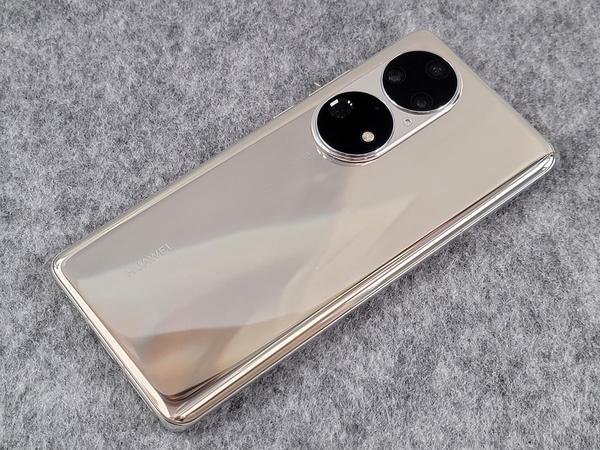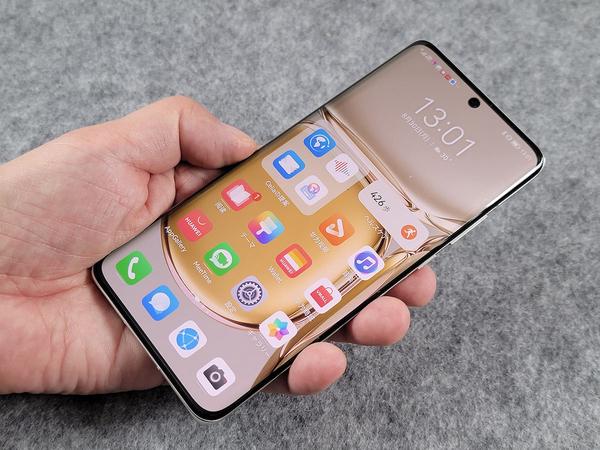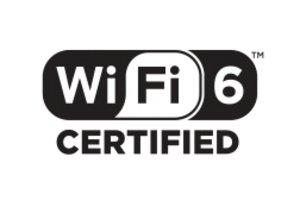Huawei "P50 Pro"
The P50 Pro has a 6.6 inch display. It has a shape called edge design that curves the display to the side. Many of these products are difficult to hold because you are worried about accidental touching on the side or the display hits your palm. The P50 Pro has a high hold feeling because the frame from the back side covers more than half of the side surface, and the body weight is 195 g, which is less than 200 g, so it is easy to hold. This "ease of holding" is a part that cannot be seen in the specifications table of smartphones, but it is a part that you want to emphasize in daily use.
The color of the model I purchased is gold. The back has a glossy finish. The design with two large circular camera pedestals is very different from the recent square or rectangular camera design such as iPhone, and you may feel a little near future. It has a triple camera on one side and one camera on the other side, for a total of four cameras.
The camera is equipped with a high-performance camera that makes you think of Huawei.
The main is bright with 50 million pixels F1.8, and the super wide angle is also high image quality with 64 million pixels. The telephoto camera is a periscope type, supports a maximum digital zoom of 100 times that of the main camera, and has 64 million pixels. In addition, it is equipped with a monochrome camera to assist in color and sharp expression, but this also has 40 million pixels. With all four cameras equipped with more than 40 megapixels, it can be said that there are no longer any drawbacks when it comes to cameras. In addition, like the successive P series, it is supervised by Leica.

Below are some examples.

The main body specification is Kirin 9000 with a high silicon chipset. Although it was last year's chipset, it still has sufficient performance. The OS is equipped with Huawei's original Harmony OS 2. The combination of both does not cause stress in operation.
HarmonyOS 2 is a more advanced version of the Android OS, and has improved usability in many ways. For example, the app icon and widget are fused, so if you tap and hold the app icon on the home screen, you can paste it as a widget as it is. Press and hold the camera icon to create a widget with four shortcuts: "snapshot, photo, video, portrait" (you can leave the camera app icon as it is). If you want to make the screen cleaner, you can leave only the icon, and if you want to perform various operations immediately, you can paste it as a widget.
You can also enlarge the folder that contains the application icons. Then you can see the shape of the icon, so it will be easier to start the application by tapping it as it is. Even if the number of apps increases and the folders are full, you can see the shape of the icon so you can see which app is in it at a glance.
You can also launch the same app and easily switch between multiple HarmonyOS 2 terminals. HarmonyOS 2 smartphones can share each other's cameras. I also have a Huawei Mate 40 Pro, but I can control the camera of the Mate 40 Pro from the P50 Pro side. If you are shooting a video, you can also shoot a seamless video while switching between the two cameras.
HarmonyOS 2 is easy to use in such small details and is good at linking different models, but unfortunately it does not support Google services. Therefore, there are some places where it is a little difficult to use, such as having to operate the SNS application with a browser. There is no choice but to wait for the political settlement to be settled quickly in this area. I sincerely hope that the day will come when major apps will be available on Huawei smartphones.
Also, on the communication side, this is also affected by sanctions from the US government, and it is a bit disappointing that it does not support 5G and only 4G. In Japan, 5G is still a long way off, but in Hong Kong, where I live, not only downtown areas but also places where many people gather are covered by 5G, and I am accustomed to using a high-speed communication environment every day. Therefore, it is common to use tethering of other 5G smartphones for high-speed communication.
The price of P50 Pro starts from 5,988 yuan (about 102,000 yen) in China. There are many out-of-stock items, so it is probably a popular product in China. It's been about 3 weeks since I started using it, and I haven't complained about the camera performance. However, it is necessary to leave the apps and services that you normally use to other smartphones. Like Huawei's smartphone a few years ago, I'm still enjoying shooting with the P50 Pro's camera, hoping that the day will come when I can use Twitter etc. on the P50 Pro as it is.


